Meditating for actualisation #
Before doing yoga (or any other things), you have to put yourself into a proper state.
Energetically a man represents a ball, or better say an oblong ellip-soid, but this ball can have many holes, punctures and energy outflows. In fact we go on arguing in some unfinished discussions, attach to some exterior objects, plan something for the future and regret about some-thing already done. All these states cause outflows of energy, its «stick-ing» somewhere. There is a law of energy: «Energy goes along with your thought». So being physically in one place, energetically, emo-tionally (which is the same), we are at the same time in various places and situations. It is unfavourable in everyday life, because it weakens us, makes us less efficient; but especially dangerous this state is when we practice yoga. There is a principle I call «a principle of balloon»; if you puncture a hardly inflated balloon, the air will leave it slowly, but, if you puncture it well inflated, it may explode. Having energy holes and significant outflows, it makes no sense to practice yoga, because all the energy we pump during yoga session will immediately leak by our «tails». To avoid this, before starting we must liberate ourselves from such energy outflows, concentrating all our consciousness on ourselves and on the process we are in, to feel being «right here and right now». Like the octopus draws in its tentacles, we should keep all the energy to ourselves. «Gheranda Samhita» puts this technique this way:
«As soon a Chitta, which is unsteady and has tendency to wander, exits the gate of feelings, you must harness it and put under control of Atman» (4. 2).
The criterion of a succeeded meditation is the feeling of warmth all over the body.
When you practice, especially when your body is significantly en-ergized (remember the principle of balloon), your mind can leave the «here and now» again and wander somewhere else. Then the actualisa-tion meditation should be repeated during the practice.
For meditation you must sit in one of the following meditative pos-es. The crucial element is a straight back, because we have a tendency to stoop at the level of depressed chakras, i.e. those zones, where there is an energy outflow. To avoid consolidation them by medi-tation, you must sit into a straight harmonious pose, even if in the be-ginning it may seem uncomfortable. By the way this discomfort can be used to actualise, by concentrating on it, your psychological problems that are causing it, and eventually start solving them (see the chapter «Meditation in yoga»).
Mentally pass all your chakras; if you see an outflow, take the energy back. Pass the Cosmos energy from the crown of your head along your spine down to the coccyx. Move your attention to the heart zone, smile by your heart to everyone present, to all living be-ings.
Meditative poses and mudras #
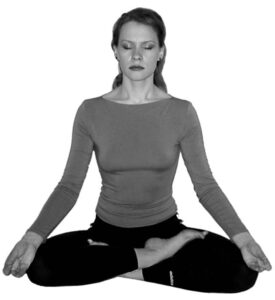
पद्मासनम् [padmāsanam]
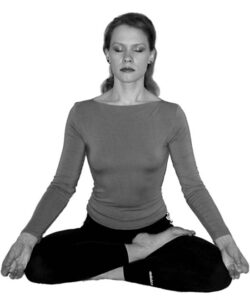
अर्धपद्मासनम् [ardhapadmāsanam]
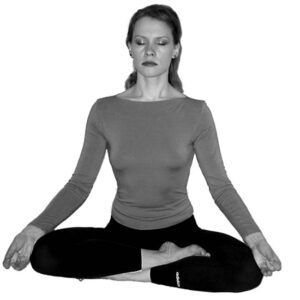
सिद्धासनम् [siddhāsanam]
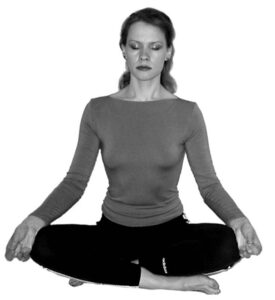
सुखासनम् [sukhāsanam]
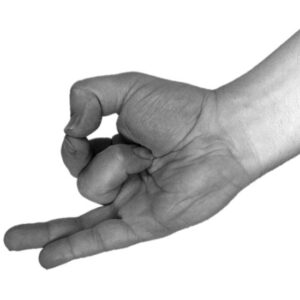
ज्ञानमुद्रा [jñānamudrā]
Full yoga breath (rhythmical breathing) #
They say «Eyes are the window to the soul». It is true, but in this case the second window to the soul is our breath. By the type and particularities of breathing you can tell almost everything about man’s emotional sphere; and vice versa by changing our breath, we can sig-nificantly change our state.
Usually people don’t breathe by their problem zones. If a person has a weak Manipura, he breathes only by the chest. If he has a weak Anahata, he breathes with the belly. If a problem zone is the solar plexus, he breathes with the «gap», somehow inhales with his chest and belly, missing one zone. If Anahata and Manipura cannot work simultaneously, then inhaling by the chest, we exhale by the belly. If Anahata’s zone is blocked, we usually compensate it with Vishuddha — lifting the chest. The most awful breathing I call «spine breath», which is done by moving one’s back-bone — it is very harmful, because it breaks the heart’s work. The more superficial our breath is, the less respiratory muscles we use, the more problems we have.
The opposite is also true: unblocking these zones, as well as respiratory muscles that were not used, we stimulate corresponding chakras and their psychological functions. So learning to breathe with the chest, we learn how to love and to feel joy of life; breathing by our belly, we stimulate the sense of inner power and our social adaptation; breathing by the clavicles, we liberate our right to express ourselves, the right of the inner liberty.
Practicing yoga (except for special therapeutic techniques, about which we’ll speak further) the best way to breath is with full yoga breath (FYB), also called rhythmical breathing. Such breathing activates all respiratory zones with no exception and in the right order, harmonising all chakras and providing the correct oxygen/carbonic acid ratio in the blood.
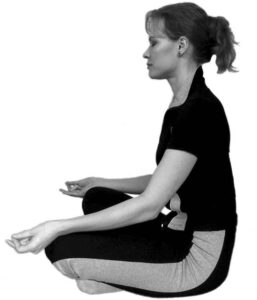
Спина викривлена в районі нижніх хребців. Таким чином найчастіше сидить людина у разі травми куприка. Якщо сидіти рівно складно, слід підкласти під сідниці тонку подушку.
Some yoga origins claim that a slowed rhythm of breathing can significantly prolong our life, because a human being has a limited number of breathing cycles, so the slower he breathes, the longer time he can enjoy this resource. This statement is hard to prove, but psychotherapists also have noticed such a pattern: the more serious is the patient, the more superficially he breathes. So the relation with the life duration is obvious.
Usually mastering FYB causes certain psychological difficulties. A man just does not notice that he misses some zones in breathing, from «inside» it seems to him that everything’s all right. That’s why before mastering full breath, we must perfectly master three auxiliary breathings, each of them having its important therapeutic effect.
1. Abdominal breathing, which goes from its name, is breathing just by the belly. To control it, you can put one hand on your belly and another — on your chest — it must stay completely still. Inhaling, the belly must stick out at the maximum, but not with the help of abdomi-nal muscles — only by the air pressure. Exhaling, the belly sticks in as much as it can.
This exercise is supposed mastered, when you can breathe this way without much effort and discomfort, keeping the rhythm for at least five minutes.
WARNING! The abdominal breathing lowers arterial pressure, so hypotension patients should be more careful performing this exercise. Hypertension patients can use it as a therapy and as an urgent self-aid, if they run out of meds.
2. Chest breathing is breathing with your thorax, just due to expansion of the chest and consequently widening of ribs. Most of modern people breathe harder by their chest, than by their belly, due to the blocked Anahata and the incitation to develop Manipura, more relevant to social realization, although just 20 years ago in the USSR the situation was contrary: people were easily breathing by their chest and could hardly master belly breath. At the Soviet times the strong Manipura was not just useless, but dangerous. Taking into account these difficulties, let’s look at some details of performing this breathing.
First of all our ribs have several degrees of widening, of which we at the best usually use just one. Our thorax can be widened forward, by sides and up. Mastering the chest breathing, it’s better to check for activating all degrees of liberty, i.e. to widen the chest equally and extensively, like a rubber ball. If your chest moves only forward or what is more often, entirely up, you should develop all missing respiratory degrees of freedom. By the way, psychologically breathing only «up» is related to the incapacity to express one’s feelings, while «moving forward» tells that these feelings are insufficiently deep.
Some people find it difficult to «switch off» belly-breath, in this case they can use a belt or something of this kind to cord the belly in order to block the possibility to breathe by abdominal muscles. You can also ask for someone’s help.
The common mistake is also to substitute the chest-breath for spine-breath: instead of widening ribs the practitioner moves ahead his entire thorax or strengthens his back, so that on the front view «it looks right». Of course all these are pathogenic types of breathing. To abandon this habit, you can practice breathing, lying on the floor or with your back pressed to the wall.
Like in the first case, the exercise is mastered when you can breathe like this with no discomfort or extra efforts, keeping the rhythm for about five minutes.
WARNING! ГContrary to the belly-breath the chest-breath raises the BP, so hypertensive patients should be alert.
3. Clavicle breathing. Is done by the upper part of the thorax, due to its insignificant widening and stretching up.
The full yoga breathing is a combination of these three types of breathing.
Technique. Inhale by the belly, then by the thorax, then by the clavicles. Exhalation is done in the same order: from the belly, squeezing the ribs, dropping the clavicles.
Healthy respiratory muscular system #
The main respiratory muscle is the diaphragm, with which other muscles cooperate: intercostal, pectoral, abdominal and shoulder girdle.
External intercostal muscles and anterior (interchondral) inter-nal muscles are those of inhaling; posterior (interosseous) internal intercostal are the exhaling muscles. Muscles of the anterior abdominal wall — external and internal oblique and internal and external transverse and rectus are also exhalation muscles. Scalenes and ster-nocleidomastoids lift our thorax and set it, also working for inhaling. The same function can be done by trapeziform, pectoral and serratus muscle.
Recently another muscles’ group role became clear — of the throat, tongue and soft palate. They receive an impulse, coming into a neurorespiratory drive some dozens of milliseconds before the impulse, going to diaphragm and pectoral muscles, providing by its contraction a normal potency of airways. We usually didn’t consider them as respiratory muscles or muscles at all. Meantime just the soft palate has five groups of muscles, controlled by III, IX, X and XI pairs of cerebral nerves, forming pharyngeal plexus.
Inhalation is done by widening of the thorax in tree dimensions: lateral parts go up (increasing dextro-sinistral size), anterior part lifts (increasing the posterior-anterior size) and diaphragm goes down. At the vertical position men and women normally have a rib (chest) breathing, lying on the back — mostly diaphragmatic (abdominal).
Arbitrary change in the volume and speed, together with the effort, inhalation and exhalation — while talking, shouting, singing, playing musical instruments etc is usually done by diaphragm-abdominal breathing.
Respiratory muscle system also takes part in various actions, directly no related to breathing: in playing musical instruments, coughing, vomiting, defecation and others. The primary participation of these or others groups of respiratory muscles in these acts depends on its nature, the needed effort, body position etc.
Doing FYB correctly. After auxiliary breathings are mastered, the most common mistakes while practicing FYB are:
1. Inhaling by the chest you «blow off» the belly, pumping all the air to the chest. So the total volume of inhaled air significantly decreases. Such problem is typical for those who cannot live at the same time by Manipura and by Anahata, i.e. to use force, while loving and not hating a person, with whom they interact (needed, for example, for parents, punishing their kid not hating, but loving him). You should be careful not to decrease the volume of the belly at the rest of the inhalation.
2. Trying to breathe «with the spine», bending it when inhale and unbending at the exhalation. This is the most harmful way to breathe. To get rid of this custom, you should practice breathing in lying on your back.
3. Dropping the chest. After the inhalation is done, you should be careful to keep your respiratory muscles working, i.e. not to drop your ribs until you exhale by your chest. Otherwise your lungs will press the pericardial sac, hampering its work and provoking shortness of breath or even tachycardia.
4. Getting out of rhythm. The rhythm of breathing should be natural, i.e. easy to keep for quite long without any discomfort. Your natural rhythm is defined by the possibility to breathe without losing your breath. The criterion of doing FYB right (as well as any other pranayama) is the fact that you don’t need to recover your breath. This breathing should naturally transform into your common breath. If you practice it regularly, your breathing cycle will become longer and you rhythm — slower, but it must be natural. In some yoga books it is recommended to practice breathing, counting till 8, 14 and even 30. This is fine, but it is reckoned on experienced yogins and can be harmful for beginners, because such a slow breathing may lead to breaking the rhythm (you’ll wish to recover your breath after this practice), or even to malfunction of the cardio-vascular system.
5. Overtension in muscles. You should not make an effort at the end of exhalation.
You’ll know that you are doing FYB the right way, if after 5-7 minutes of the exercise you feel warmth inside. Sometimes there is a light feeling of vibration or the even appearance of sweat, which also confirms, that the energy is activated in our body.
At the beginner’s level start practicing FYB for 10-20 minutes a day, lying on something firm, before you go to sleep. It’s important to do it on a firm surface in order to have a perfectly straight back, because when people start practicing yoga, they can hardly sit straight, and breathing in the curved pose would only secure a pathogenic posture.
After a month of such practice you usually become more energetic, start seeing bright dreams and sleeping better. In fact one of the signs of an increased energy are brighter dreams.
You mustn’t do rhythmical breathing lying in your bed, even a very firm one, because it has its «sleeping» energy. When you sleep, a certain amount of your astral energy liberates and you get «switched» to some astral places where you go in your dreams, which hampers, when you practice exercises. That is why Pythagoras recommended to make one’s bed — not from domestic, but from esoteric considerations. The bed should always be made after the sleep and better even hidden, because it keeps astral «switches».
Doing yoga you should always remember about your comfort, by the way like in any other occupation. Caring about your comfort is a practice of Svadhishthana and Muladhara.
Position of eyes during yoga practice #
Where to look and at what to focus our look while doing yoga? Should our eyes be opened or closed? These questions appear from the first sessions, but to answer them correctly let’s consult physiology and psychosomatics of the vision. Talking about the connection between our eyes and psyche, let’s note the following.
1. Involuntary eye moves are caused by wandering of our mind. One of yoga’s tasks is Dharana, the stable state of mind. All psychosomatic processes are reversible, that’s why the eyes can serve not only a great indicator of the state of our mind, but also a lever to influence it. In other words, if nothing else is previewed (like in the eye gymnastics) when you practice yoga, your eyes should be motionless.
2. There is an empirically proved interrelation between where you look and your state of psyche. A look below the horizon activates our subconsciousness, above the horizon — superconsciousness, eyes parallel to the ground — our consciousness. Yoga is mostly aimed at development of our consciousness, so in most exercises the look should be zerolow.
3. Maybe you’we already noticed that when a person concen-trates on his own problems, you can see it by a specific distracted look in his eyes, which become motionless and focus at the point 15-20 cm before his face. The look becomes empty. On the contrary, the image of a strong man is associated with the look into the distance. Indeed a point of natural eye focus is related to our capacity to extend our mind, to transcendent: the broader is one’s consciousness, the easier he can look far to the horizon and keep this focus. Narrow-minded people can hardly look afar. The contrary is also true: wittingly keeping our look at the «eternity», helps to widen our consciousness. That’s why practicing yoga, your look should be focused at the «eternity» (as if looking into the distance), if other isn’t suggested. This focusing should be kept even if your eyes are closed.
4. Of course with closed eyes it is easier to digress from outer irritants. That is why when you start practicing yoga you should do all the exercises with your eyes closed, although then it is much harder to keep your mind stable. That’s why at some point it becomes reasonable to practice with the open eyes. As for the experienced practitioner, it doesn’t matter how to keep his eyes during the yoga class.
5. Remember that through our eyes we can receive or lose energy.
6. Some books recommend rolling up your eyes to focus them between the eyebrows. We can easily notice that whatever the position of the body, this focus inducts a specific euphoric high state, which is by mistake recognized as an effect from asana. Such state brings no good, it just distracts our consciousness from the body; that’s why I strongly don’t recommend doing it.
So in most exercises our look should be focused at the horizon¹ .
In meditative poses you can often see a tendency to throw back your head, thinking that your spine is straight. If you throw back your head, almost all your muscles reflectively strain. No matter what hap-pens, you should always reach the top of your head up and slightly forward.
Note
1. Some sources call this eye position «Vaishnavi mudra». ↑
Orientation during yoga session #
Most of Indian origins recommend doing exercises facing the North or the East. In ancient India these directions were sacred, but in other traditions, like esoteric qigong, we can find more complex approaches, relating orientation during the practice with your current tasks, seasons and even Moon phases, but even this approach implies outdoor practice where the natural electromagnetic field of the Earth is not distorted by man-caused influences. In the cities and condominiums with their reinforced concrete constructions, where modern yogins have to practice for the most of time, things are different. That is why the most favourable orientation should be found personally, guided by inner feeling.
